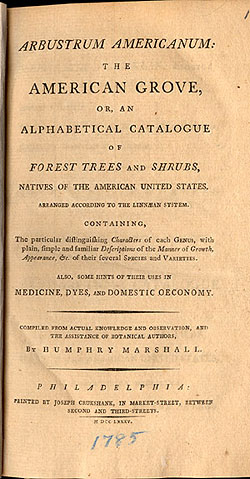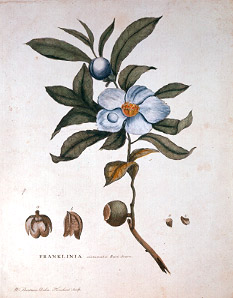 |
Title page of Marshall's Arbustrum
(click to read Marshall's introduction) |
A younger cousin of
John Bartram's, Humphry Marshall (1722-1801) was another of the remarkable circle of Quaker botanists from Chester County, Pa., who helped shape American botanical practice during the 18th and early 19th centuries. His most enduring work, the
Arbustrum Americanum was fittingly published only two years after the Peace of Paris had formalized American independence, and is recognized as the first botanical treatise written by a native American on American plants, produced in America.
The rudimentary education that Marshall received ceased altogether when he was apprenticed to a stone mason at the age of 12. Like Bartram, he displayed an avid interest in natural history from a very early age, and with his cousin's encouragement and advice, developed considerable skill as a practical botanist as early as the 1740s, and like Bartram, he soon came to the notice of the Anglo-American scientific community as a collector and supplier of native plant and animal specimens. During the middle years of the 18th century, Marshall's renown grew steadily. His circle of correspondents and clients swelled, often expanding along the connections provided by family and fellow Friends - the personal and religious acting in the service of the commercial and scientific - and his avocation of providing plants to interested parties soon became a vocation. Eventually, Marshall's correspondents came to include some of the leading botanists in England, America, and the Continent, including Peter Collinson, John Fothergill, Sir Joseph Banks, John Coakley Lettsom, Benjamin Franklin, George Logan, Timothy Pickering, John Dickinson, Caspar Wistar, Hector St. Jean de Crèvecoeur, and Johannes Fredericus Gronovius.
In 1764, success had encouraged Marshall to construct a conservatory on his farm for the culture of rare plants -- probably the first such structure in Chester County -- and with the inheritance he received upon the death of his father in 1767, he was finally able to turn all of his energies to science. On April 8th of the next year, Marshall was elected a corresponding member of the American Society, one of the organizations that merged to form the modern American Philosophical Society, and although he never attended a meeting, he remained in regular communication with the Society until his death. By 1772, Marshall's estate had become a full fledged export-oriented botanical garden stocked with herbaceous and arboreal representatives of the local flora and as many exotic plants as could be obtained from other parts of the nation and Europe.
Although the trans-Atlantic traffic in plants inevitably suffered during the American Revolution, it did not altogether cease, and relatively speaking, Marshall's business escaped unscathed. A member of West Bradford Meeting, he was too good a Friend to be active in the revolutionary cause, but he was nevertheless in general sympathy with independence, and was a fervent supporter of the non-importation movement and the later movement supporting domestic manufactures.
 |
| Dedication page of Marshall's Arbustrum |
Marshall's scientific publications were few, including contributions on the natural history of tortoises, sunspots, and agriculture, however he is most remembered for his magnum opus, the
Abrustrum Americanum (1785), dedicated to Benjamin Franklin and the other members of the American Philosophical Society and framed in the APS tradition of providing "useful knowledge." While not specifically devoted to the botany of the southeastern United States, this work is an important contribution to the botanical study of the region. Having long studied plants acquired on expeditions or by local suppliers in the Carolinas, Marshall was well familiar with the southern flora.
Intended as an exhaustive list of the tree and shrub "Natives of our United States," as well as a catalogue for botanical clients, the Arbustrum is also a work that implicitly asserts the value of the American flora and American science. Although couched in terms of the utility of plants for medicine, agriculture, and horticulture, and arranged alphabetically to that end, the Arbustrum is a work of advanced science, employing the newest Linnaean taxonomic nomenclature. Marshall hoped, as he claimed in a prospectus for the work, to spur additional research on American botany, claiming that an exhaustive survey of American plants "cannot be compiled at once, or by one man; but it is the duty of every one to contribute what he can towards it." When sending a copy of the work to the APS (and separately to Franklin), he encouraged the Society to organize a scientific expedition to the western reaches of the continent. Not coincidentally, in 1792, his nephew and assistant, Moses Marshall (1758-1813) was approached by Caspar Wistar and Thomas Jefferson to undertake an expedition to the Pacific - an expedition eventually placed under the command of André Michaux and a precursor to the Lewis and Clark expedition of 1803-1805.
 |
Franklinia altamaha,
drawn by William Bartram
(click to read Marshall's description of Franklinia) |
Although the
Arbustrum sold only about a dozen copies in the United States during its first three months, it attracted interest in European scientific circles and appeared in both French and German translation by 1788. Marshall's description of John Bartram's discovery of
Franklinia altamaha -- a plant collected by John and William Bartram, and not recorded in the wild since - surely helped to propagate the legend of that famous plant. When Moses Marshall led an expedition to the Carolinas and Georgia in 1790, he was specifically charged with locating specimens of
Franklinia for Sir Joseph Banks, and succeeded in doing so along the banks of Alatamaha River. The last recorded sighting of a
Franklinia in the "wild" was in 1803, and all extant specimens of the tree are descended from Bartram cultivars.
Sadly, the Marshall dynasty proved even less durable Franklinia. Although initially keen on continuing in his uncle's botanical footsteps, Moses Marshall's interests began to wane by the mid-1790s, and the press of family demands and business concerns soon caused him to neglect Marshall's garden. By the time of Moses' death in 1813, the garden was in ruins.
The APS copy of Marshall's Arbustrum Americanum was donated to the Society by the author in January, 1786.



